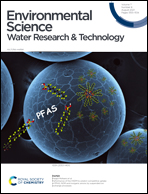The synthesis of novel FeS2/g-C3N4 nanocomposites for the removal of tetracycline under visible-light irradiation†
Abstract
Novel FeS2/g-C3N4 (FC) composites were successfully constructed using an impregnation–calcination method, and they demonstrated a wonderful visible-light catalytic performance compared with unmodified g-C3N4 and FeS2. The structures, morphologies, and chemical states of the samples were characterized. The photocatalytic performance was assessed based on the removal of tetracycline (TC) under visible light. The removal of TC by 20%-FC reached 83.5% within 180 min, much higher than when using g-C3N4 or FeS2. The improved degradation of TC was a result of the introduction of FeS2, which obviously enhanced the separation of photogenerated carriers at the firmly contacted interface. The effects of the key operating parameters were further explored, including the doping ratio, the concentration of photocatalyst, and the pH value. The photocatalytic theory of charge division was demonstrated using quenching experiments and electron spin resonance (ESR) studies. Finally, the FeS2/g-C3N4 composite exhibited remarkable recyclability and stability. This study creates new prospects for the synthesis of photocatalysts and for the degradation of resistant organic pollutants for environmental remediation.



 Please wait while we load your content...
Please wait while we load your content...